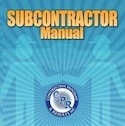It’s summer when a lot of production is typically happening. I want to discuss a few topics that are often neglected when we get busy building jobs. They aren’t earthshaking topics, but they’re the things that cause problems on jobs, and we all know that problems lead to disgruntled clients, lost referrals, and lower profit margins.
Ordering Materials for the Job
Immediately after the pre-job layout (read more about pre-job layouts here), every project should be reviewed to see what materials need to be ordered and when. This should be done by both the person who will run the job and the person who sold the job.
This task requires a high level of concentration. You need to have your head in the game. That means being in a quiet area with your phones unplugged or turned off, and potty stops and lunch taken care of. Focus on the task at hand with no distractions so you don’t make mistakes.
Subcontractor Manual
General contractors, get expections in writing. Fully customizable, edit to match company policies.
Order it Here
Review the job in detail. It helps if you have a Gantt chart for the job as a reference point. (If you aren’t familiar with a Gantt chart for construction, you can see one here.) Every material or product is considered, and a determination made as to when it will be needed on the job. From that, an order date is set and those order dates are entered on the Gantt chart. Now it’s simply a matter of faithfully following the chart.
I’ve had job superintendents tell me they don’t have the time to do all that monkey motion. That’s shortsighted. It takes time to deal with what happens when windows, doors, appliances, countertops, light fixtures, etc., aren’t ordered on time and show up late. It takes time to deal with disgruntled clients because of a delayed project. The investment of time in planning ahead will save hours of aggravation and the expense of expedited shipping fees.
Change Work Orders
I’ve reviewed too many contracts that don’t address change work orders or punch lists. Using change work orders wrong, or not using them at all, is the number 2 reason construction-related businesses fail. Your client needs to understand what a change work order is, and why, when, and how it will be used. They need to understand the payment schedule for change work orders. All this needs to be both explained verbally and written down in the contract. Also, your employees need to know how to handle all change requests.
Punch Lists
Punch lists, like change work orders, are another common problem that can cost you money. It’s not uncommon for a client to bring up one problem after another to avoid making the final payment. That’s why you need to have the procedure for handling final fixes explained in your contract. We have sample language in our book Markup and Profit Revisited.
Borrowing Tools on the Jobsite
There should be a blanket rule in your company that prohibits any employees or subs from borrowing the building owner’s tools or equipment, and that should be included in both your employee manual and your subcontractor manual. You’d be amazed how often this happens, and all too often it leads to disagreements and hard feelings, especially if the tool is broken or damaged. Everyone should have their own hand and small power tools. Larger power tools and equipment should be furnished by the company. Those tools that belong to the company should be assigned to individuals for care and maintenance.
Many years ago, one of our subcontractors borrowed a homeowner’s wheelbarrow to mix some concrete. They mixed and poured the concrete but didn’t clean the wheelbarrow afterward. That was the last job the sub ever did for our company.
Resolve Issues Immediately
News flash: Stuff happens in this business, and stuff can be spelled all kinds of ways. When it happens, your number one priority is to get it fixed. Immediately. I’ve often seen small issues turn into major incidents because the simple complaint or perceived problem was ignored by the contractor. Instead of addressing the problem, the contractor stuck their head in the sand or ran the other way when they knew something was wrong.
If you or someone representing your company makes a mistake, address the mistake, and do it now. Apologize and get things right with your client so you can get back to building their job.
Everyone makes mistakes. How you handle that mistake will show your client how trustworthy and dependable you are. If you handle issues properly and promptly, showing your client you’re willing to admit your mistakes and make the wrongs right, you should still be able to ask for and get referrals when you finish the job. We talked about this in our article titled “Handling Customer Complaints.”
It’s not easy owning and running a construction company. Construction business failures rank high on the list of business failures. Planning jobs well before they start, protecting your business with pertinent contract language, and addressing issues when they happen will give your business a better chance of not just surviving, but being profitable. Let us know if we can help.
The knowledge and experience Michael Stone gained in his 60+ years in construction has helped thousands of contractors improve their businesses and their lives. He is the author of the books Markup & Profit Revisited, Profitable Sales, and Estimating Construction Profitably, and is available for one-on-one consultations.
Listen to the audio here, or select dots on the right to download:


 wpDiscuz
wpDiscuz